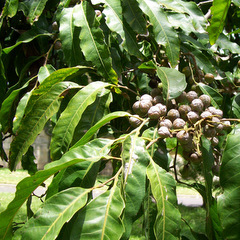Trees or shrubs. Indumentum of solitary hairs only. Flowering twigs terete, striate, rarely grooved. Leaves paripinnate, 2-6-jugate; petiole pulvinate, striate; rachis striate; petiolules usually pulvinate, flattened and grooved above, rounded below. Leaflets alternate, rarely (sub)opposite, usually (slightly) asymmetric, usually chartaceous; margin entire or (irregularly) dentate; domatia if present pocket-like to saccate. Inflorescences (supra-)axillary, thyrsoid, without or basally with 1 or 2 branches; cymes 1-flowered, bracts and bracteoles caducous, pedicels hairy. Flowers unisexual, male and female ones only slightly different in perianth. Sepals 5, (almost) free, not or basally slightly imbricate, not petaloid, almost equal, appressed-hairy on both surfaces. Petals 5, usually oblique funnel-shaped, clawed, with 2 auricles at the apex of the claw. Disc entire, cup-shaped, glabrous (in 1 Pacific species hairy). Stamens 8, exserted in the male flowers; filaments glabrous or exceptionally with few hairs; anthers hairy or glabrous. Ovary 3-celled, hairy; style apical, shorter than the ovary; stigma 3-lined; pistillode 3-celled, hairy. Fruits sessile, 3-celled, obovoid to globular or top-shaped, loculicidal, circular or rounded to sharply deltoid in cross section, wall woody, up to 6.5 mm thick, outside glabrous to velutinous, inside tomentose, rarely (Solomon Islands, New Caledonia) glabrous. Seeds ellipsoid to obovoid, testa shiny black or rarely brown, sarcotesta covering only a small part of the seed, 2-lobed or shield-like.
More
Monoecious trees. Branchlets lenticellate, hairy towards apex with simple hairs. Leaves petiolate, paripinnate; leaflets opposite to alternate, entire, serrate or serrulate, domatia usually present along midrib. Inflorescence a raceme or raceme-like or panicle-like, axillary, spike-like when young; bracts minute. Flowers regular, pedicels slender. Calyx shortly cupular, 5-partite, hairy outside. Petals 5, clawed; scales 2, auriculiform, villous, crestless. Disc regular, cupular, glabrous. Stamens 6–8; filaments filiform. Ovary sessile, 3-locular, 1 ovule per locule; style simple. Fruit obovoid, subellipsoidal or subglobose, usually 3-sulcate, loculicidally dehiscent, 3-valved; valves thick, drying woody, granular, villous inside; pericarp ±fleshy. Seed obovoid, shiny, with small, dorsal aril at its base.

